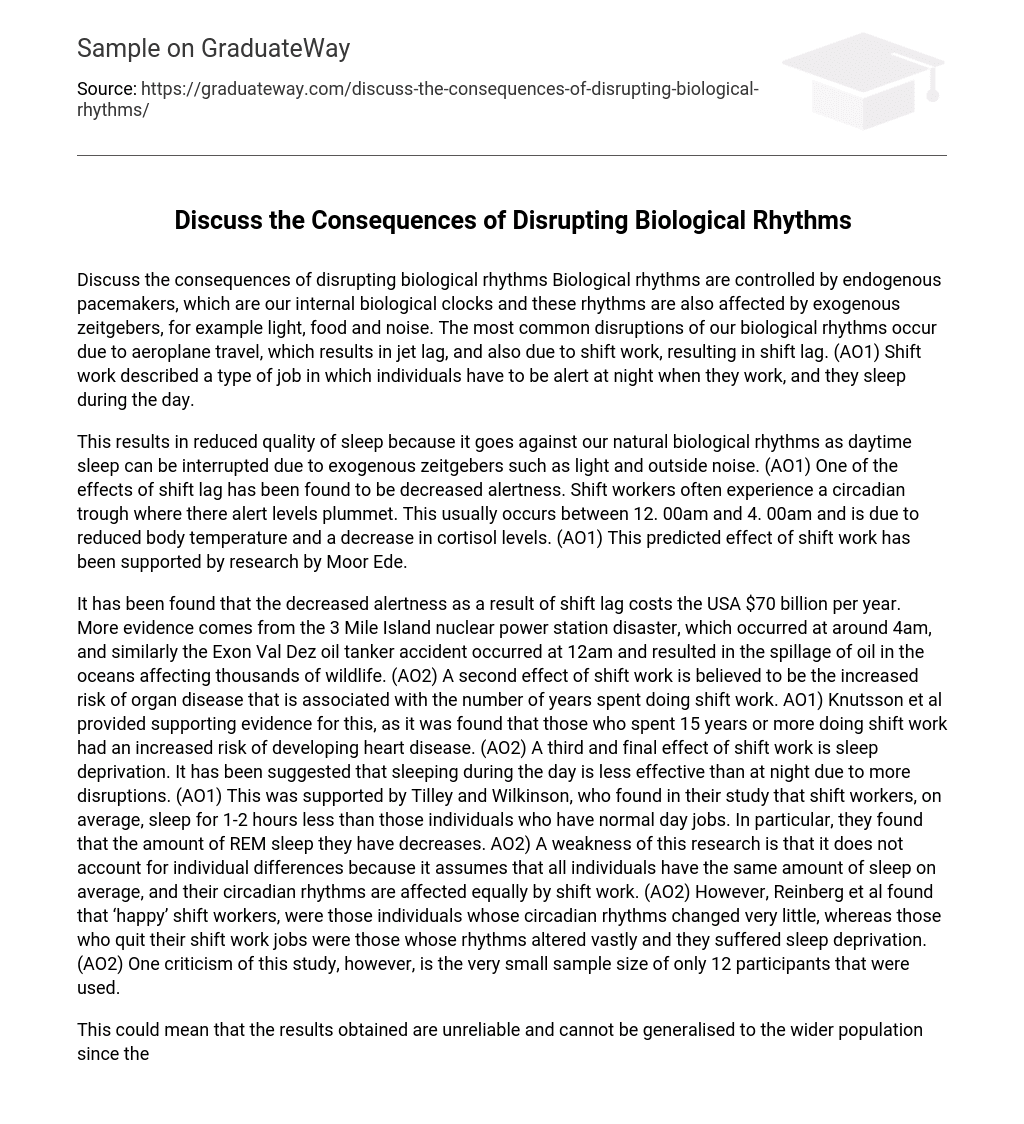Discuss the consequences of disrupting biological rhythms Biological rhythms are controlled by endogenous pacemakers, which are our internal biological clocks and these rhythms are also affected by exogenous zeitgebers, for example light, food and noise. The most common disruptions of our biological rhythms occur due to aeroplane travel, which results in jet lag, and also due to shift work, resulting in shift lag. (AO1) Shift work described a type of job in which individuals have to be alert at night when they work, and they sleep during the day.
This results in reduced quality of sleep because it goes against our natural biological rhythms as daytime sleep can be interrupted due to exogenous zeitgebers such as light and outside noise. (AO1) One of the effects of shift lag has been found to be decreased alertness. Shift workers often experience a circadian trough where there alert levels plummet. This usually occurs between 12. 00am and 4. 00am and is due to reduced body temperature and a decrease in cortisol levels. (AO1) This predicted effect of shift work has been supported by research by Moor Ede.
It has been found that the decreased alertness as a result of shift lag costs the USA $70 billion per year. More evidence comes from the 3 Mile Island nuclear power station disaster, which occurred at around 4am, and similarly the Exon Val Dez oil tanker accident occurred at 12am and resulted in the spillage of oil in the oceans affecting thousands of wildlife. (AO2) A second effect of shift work is believed to be the increased risk of organ disease that is associated with the number of years spent doing shift work. AO1) Knutsson et al provided supporting evidence for this, as it was found that those who spent 15 years or more doing shift work had an increased risk of developing heart disease. (AO2) A third and final effect of shift work is sleep deprivation. It has been suggested that sleeping during the day is less effective than at night due to more disruptions. (AO1) This was supported by Tilley and Wilkinson, who found in their study that shift workers, on average, sleep for 1-2 hours less than those individuals who have normal day jobs. In particular, they found that the amount of REM sleep they have decreases. AO2) A weakness of this research is that it does not account for individual differences because it assumes that all individuals have the same amount of sleep on average, and their circadian rhythms are affected equally by shift work. (AO2) However, Reinberg et al found that ‘happy’ shift workers, were those individuals whose circadian rhythms changed very little, whereas those who quit their shift work jobs were those whose rhythms altered vastly and they suffered sleep deprivation. (AO2) One criticism of this study, however, is the very small sample size of only 12 participants that were used.
This could mean that the results obtained are unreliable and cannot be generalised to the wider population since they are unlikely to be representative. (AO3) Moreover, another limitation of the findings is that they have gender bias because the study was only conducted on male participants. We could say that they are ‘alpha-biased’, and cannot be generalised to female since they may have produced different results. (AO2 Synoptic) Nevertheless, a strength of the research by Tilley and Wilkinson is that it reflects both sides of the nature nurture debate. It accounts for both environmental factors e. . light and noise, and its effect on the innate biological rhythm of the sleep wake cycle. (AO2 Synoptic) A second disruption of biological rhythms is due to jet lag. This term is used to describe the physiological effects of disrupting our circadian rhythms. Symptoms of jet lag include loss of appetite, nausea, fatigue and insomnia. It has been found that travelling east has a more pronounced effect on jet lag, since it involves a phase advance (similar to getting up earlier in the morning), whereas travelling west involves a phase delay, which is easier to overcome. AO1) Supporting evidence for the effects of jet lag come from a study by Recht et al. He studied a US basketball team and the matches they played over a 3-year period. It was found that when they travelled east they won only 37% of their games, whereas when they travelled west they won 44% of their games. This supports the prediction that jet lag causes performance decrement. (AO2) One weakness of this study and its results is that they may be culturally biased.
This is because the study was conducted in the USA, which is an individualistic, westernised country, and the same results may not have been found in a non-Western country. Therefore the results cannot be generalised to others with confidence (AO2 Synoptic) Yet another limitation of this research is that it can be considered to be reductionist. The effects of aeroplane travel are only explained in terms of performance decrement due to travelling and no account has been made to the unusual behaviour that occurs, for example watching many films consecutively or in flight drinking.
It is possible that jet lag occurred due to these factors rather than travel itself. (AO2 Synoptic) On the other hand, a strength of this study is that it was in fact a natural experiment. Therefore, the results can be described as having high ecological validity and representative of similar situations in real life. However, the researchers would have had no control over extraneous variables such as diet and sleep, therefore we cannot conclude cause and effect i. e. that jet lag was caused by aeroplane travel. (AO3)





